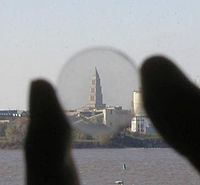
Photo from wikipedia
(111) NiO epitaxial layers are grown on c-sapphire substrates by pulsed laser deposition technique. Structural and morphological properties of the films are studied using in-plane as well as out-of-plane high… Click to show full abstract
(111) NiO epitaxial layers are grown on c-sapphire substrates by pulsed laser deposition technique. Structural and morphological properties of the films are studied using in-plane as well as out-of-plane high resolution x-ray diffraction and atomic force microscopy techniques as functions of growth temperature, oxygen pressure and the pulses count of the laser. The study shows that continuous epitaxial films of thickness as low as 3 nm with high crystalline quality, smooth surface and interface morphology can be grown by this technique. The study also reveals the co-existence of 60°-rotated (111) triangular domains of NiO in the film. The study also evidences the presence of a very low density of 60° dislocations in these films. Density of screw and edge dislocations are also estimated to be quite low. It has been found that growth-temperature, oxygen partial pressure and the film thickness can influence differently the density of various dislocation types. These parameters are also found to affect significantly the strain developed in the films.
Journal Title: Semiconductor Science and Technology
Year Published: 2021
Link to full text (if available)
Share on Social Media: Sign Up to like & get
recommendations!